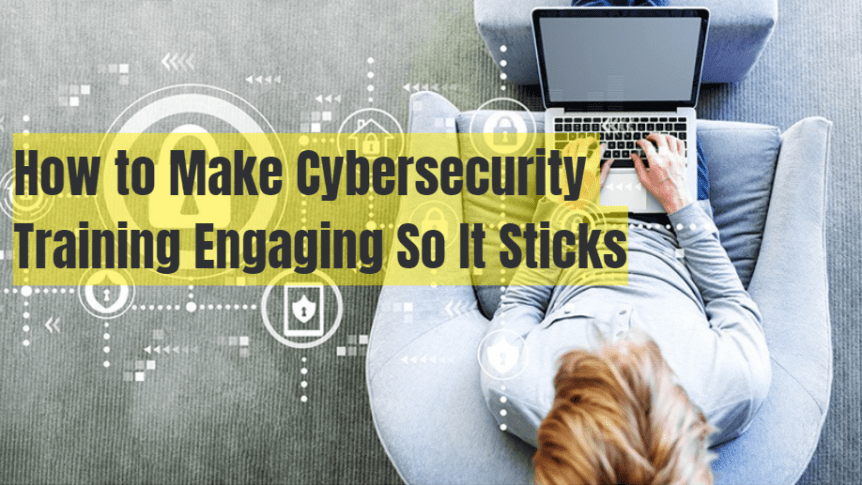How to Make Cybersecurity Training Engaging So It Sticks
Cybersecurity training is essential in almost all companies and organisations but one of the most challenging aspects is how to make it stick. How do you get employees to focus, buy in, and engage when they are busy, may not be interested in the detail of the topic, and have other priorities?
It is crucially important to create cybersecurity training that is engaging as your staff play an essential role in the protection of your company’s systems and data. The following 10 tips are beneficial for making cybersecurity training engaging.
Make Sure the Content is Relevant
Making content relevant is important for all types of training. Given the stakes, content relevancy is even more important for cybersecurity training.
Making content relevant means using examples and scenarios that employees will be familiar with, from situations that employees might encounter to software applications that are used.
There is one caveat to this point, and that is to make sure employees know that cybersecurity threats can come from anywhere, including situations they have never encountered before. But to make your training as engaging as possible, it helps to keep the content relevant.
Use Storytelling
Cybersecurity can be an abstract concept for many people so it is beneficial to use storytelling to underline the importance of both the training and the best practices and guidelines that should be followed. For example, use a real-world example of what happens when a company is attacked, including how the attackers got in, the damage they caused, and the consequences.
Explain What to Do
Cybersecurity training is often about what you shouldn’t do – don’t click on this link, don’t open that file, etc. This is necessary, but there should also be more of an emphasis on what employees should do. What should they do if they encounter a suspicious message or email, what steps can they take to improve cybersecurity, etc?
Videos
Including videos in your e-learning cybersecurity courses is a great way to enhance engagement, especially if you use interactive videos.
Simulations
Simulations in e-learning courses are a fantastic learning tool as they allow employees to practice, learn by doing, and learn from mistakes. Simulations (also known as scenarios in e-learning courses) can be designed to challenge learners and demonstrate how potential security breaches can occur.
Include an AI Tutor
There are likely to be some learners completing the cybersecurity training who will get it and don’t require much additional support. That said, there are probably others who would benefit from additional information and help. This includes having the ability to ask questions in their own words so they can get a better understanding of what they need to do to reduce cybersecurity risks.
An AI tutor is the perfect tool for providing additional help and support to your employees.
Don’t Overwhelm with Information
Cybersecurity is a massive topic area. Even when you strip away the elements that are not relevant to the learners who will complete the course, you will probably still have a lot to cover. In doing so, however, it is important to make sure you don’t overwhelm learners with too much information.
It is counterproductive to go too far with the content you include as most learners have limits on their capacity to grasp and retain new information. It is better to break the training up into chunks focusing on the most important priorities first and then building up knowledge levels over time.
Emphasize the Personal Benefits
A greater level of cybersecurity awareness along with general cybersecurity skills isn’t just beneficial for learners in their jobs. Many of the skills, best practices, and guidelines can be implemented or adapted by learners to also help keep their personal data and digital identity safe.
Add Gamification
Adding gamified elements is a great way to make e-learning courses more engaging. You could award badges to learners for completing various tasks, milestones, or achievements, and you could have a leaderboard to add a competitive element to the training.
Train Regularly
Cybersecurity is a topic that is always evolving, with new technologies and threats. It is also a topic where everyone can benefit from continuously improving their skills and abilities. As a result, it is best to provide cybersecurity training regularly.
This can include training on different cybersecurity topic areas or advancing the skills and knowledge of employees even further. It is also helpful to offer refresher courses to ensure standards are maintained with an ongoing focus on cybersecurity best practices.
It Is Worth Putting in Additional Effort
Cybersecurity risks are not only present in every organisation – they are increasing. Furthermore, there is no policy, platform, or resource that you can implement that will reduce or replace the need for cybersecurity training. The fact is, so long as it is possible for people to make mistakes, one of the weakest parts of your security infrastructure will remain your people.
All this means it is worth putting in extra effort and investment in cybersecurity training to keep your organisation protected.

